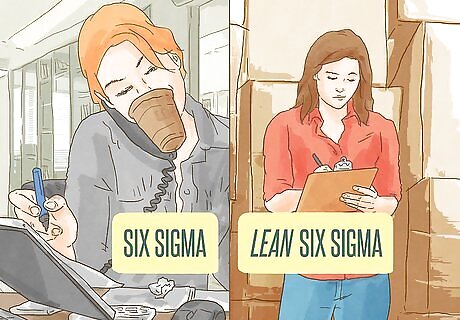
views
Determining Your Management Philosophy

Consider the needs of your organization. What kind of management style would best benefit your organization? Is it suffering from too much overhead and waste in the supply chain? Is there inconsistency in how things get done? What's the overall organizational culture?

Decide on how you want to optimize your processes. You might be someone who believes that the best way to guarantee quality is to ensure that processes are consistent across the board with as few variations as possible. On the other hand, you might be someone who opts for an emphasis on efficiency or producing a quality product with as little waste and overhead as possible.

Determine whether you want Six Sigma certification or Lean Six Sigma certification. You'll use your management philosophy to decide on whether you'll opt for Six Sigma or Lean Six Sigma certification. Six Sigma defines waste as a variation within business processes. If you're someone who believes in a consistent process, you'd probably be most comfortable with this type of certification. Lean Six Sigma is a combination of the Lean methodology and the Six Sigma methodology. It defines waste as anything that doesn't add value to the finished product. If you're looking for an emphasis on efficiency, then you'd probably prefer Lean Six Sigma certification.
Deciding on the Level of Six Sigma Certification That's Best for You

Understand your role within the organization. Are you a project manager? Are you someone who supports the project manager? Are you someone whose day-to-day work involves more than just being involved on a project that will use Six Sigma? The answer to those questions will determine the level of certification that you need.

Consider your future career goals. If your future includes project management, even if that's not where you're at now, then that should also help you determine the level of certification that you need.

Select a level of Six Sigma certification. There are four levels of Six Sigma certification: Yellow Belt, Green Belt, Black Belt, and Master Black Belt. Six Sigma Yellow Belts are people who have a basic understanding of the Six Sigma process. They tend to lend themselves in supporting roles to Six Sigma Green Belts and Six Sigma Black Belts. You won't find too many training courses for Six Sigma Yellow Belts. Six Sigma Green Belts are people who work closely with Six Sigma Black Belts and are primarily responsible for data collection. Usually, Six Sigma Green Belts will have responsibilities outside the Six Sigma project. Six Sigma Black Belts are project managers. Typically, Six Sigma Green Belts and Six Sigma Yellow Belts report to Six Sigma Black Belts within the scope of the project. These are people who are typically dedicated full time to the project. Six Sigma Master Black Belts are Six Sigma "gurus." They're the experts in a team of highly trained Six Sigma professionals. They're the people that the team will turn to when the unexpected occurs and a course correction may be necessary.
Getting Certified in Six Sigma

Locate the appropriate training program. All certifications start with training, and Six Sigma is no exception. You'll start your certification journey by locating the right training program. Since classroom instruction is almost always necessary, start by looking for training classes close to you. A simple Google search may be necessary if you have no leads on local Six Sigma training. Talk to people who have earned Six Sigma certification. Ask them about their experience with the programs that they took. If they've had a positive experience, consider enrolling in the same program. Look for programs that are accredited. Although there is no formal standards body that defines Six Sigma, there are accreditation organizations. Ensure that you're getting trained by an accredited program.

Enroll in the training program. This is going to be just like college all over again. Prepare for some rigorous study and lots of class time, especially if you're opting for Black Belt or Master Black Belt certification.

Take the written test. Once you've completed the training, the next step is to complete a written test that proves that you've learned what you need to know about Six Sigma. You can expect a Black Belt exam to last about four hours, a Green Belt exam to last about three hours, and a Yellow Belt exam to last about two hours.

Complete your assigned project(s). The final phase of your certification journey will involve completing one or two projects using the Six Sigma methodology. You can think of this as your "lab." It's subjective at this point as to how to "grade" you based on how you complete the project. Just be sure to put into practice what you learned in the classroom and you should do well.

Benefit from your Six Sigma Certification. Once you've completed the training and required coursework, you'll earn your belt. Now, it's time to tackle real-world problems.
















Comments
0 comment